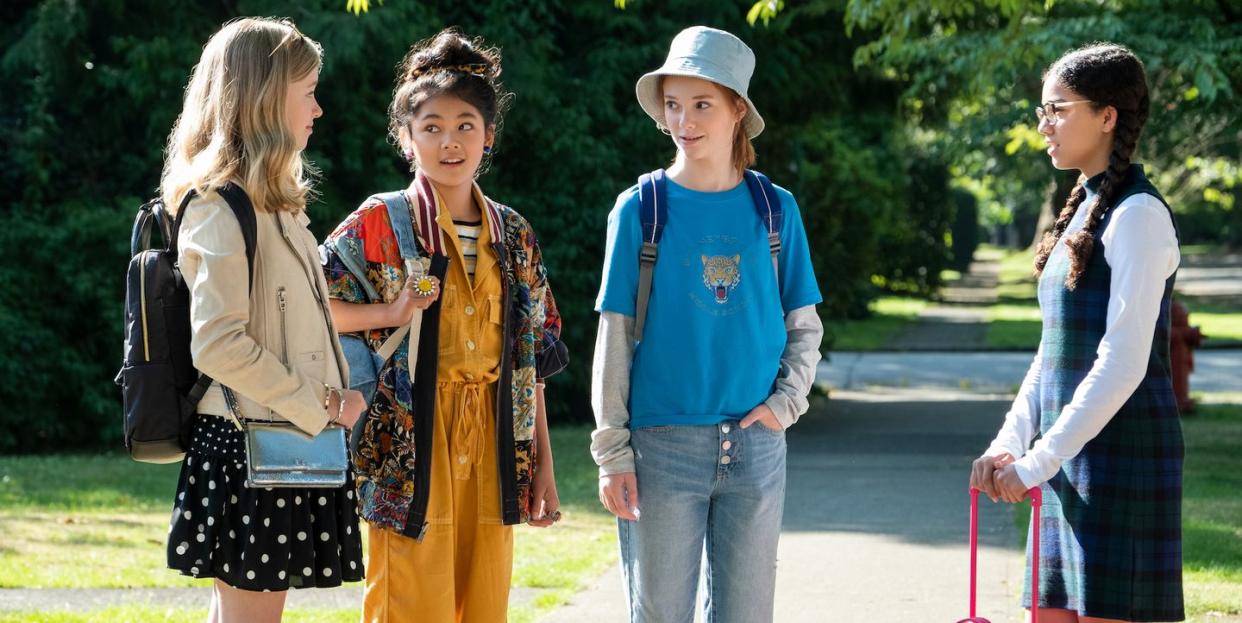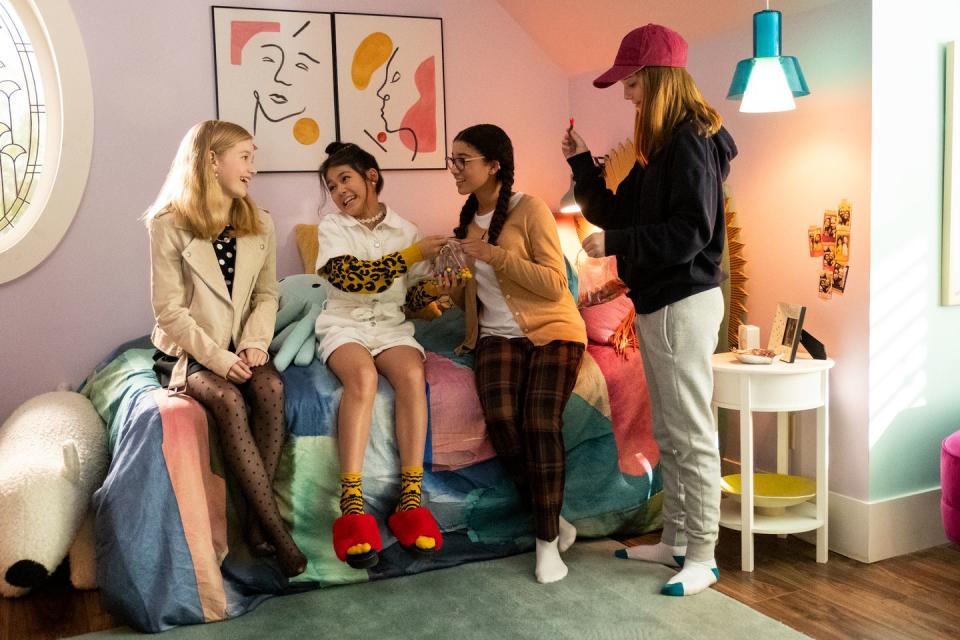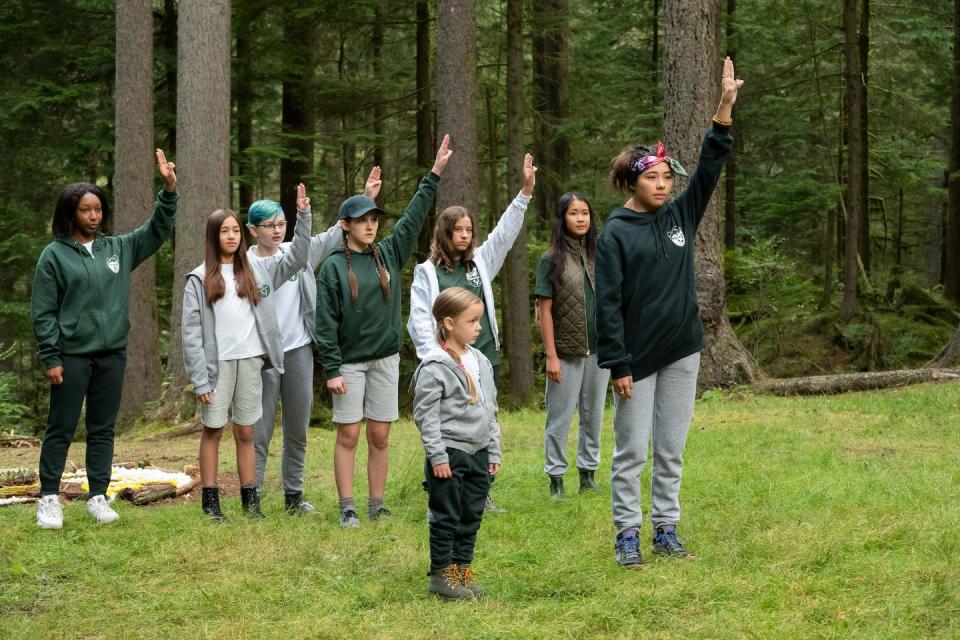Here’s What Netflix’s ‘The Baby-Sitters Club’ Changed From The Books—And Why It Works

If you’re a Kristy, you knew from the moment Netflix’s Baby-Sitters Club reboot was announced that it’d be a masterpiece. If you’re a Mary Anne like me, you were probably more skeptical. Rebooting a beloved franchise is like attempting a Pinterest DIY—so common it supports an entire industry, yet so easily mishandled it’s a safety hazard. Fans love stories told exactly as they remember them. Change—any change—is perceived as threat.
And, some would argue, The Baby-Sitters Club books were untouchable. First published by Ann M. Martin in 1986, they were a staple of Scholastic book fairs and tween lore for many who came of age in the late 20th century. The club’s sevenm entrepreneurs were the OG feminist icons, long before most of us understood what it meant to be a feminist icon. The Stoneybrook girls—Kristy Thomas, Mary Anne Spier, Stacey McGill, Claudia Kishi, Dawn Schaefer, Mallory Pike, and Jessi Ramsey—were independent, affectionate, funny, kind, moody, selfish, bored, brilliant, and classic. They were like us, then and now. Their stories went on to sell hundreds of millions of copies, rounding out a series of more than 200 books, which now fill boxes in attics everywhere. Daughters would beg their parents to buy them one of the Super Mysteries or Friends Forever Specials. Today’s grown women still self-identify as a Claudia or Dawn—and wear their status like a badge of honor.
So when it became clear Netflix would take some liberties with its adaptation of the series, concern was understandable. But I’d argue if you watch the first five minutes—or even the first 30 seconds—of episode 1, “Kristy’s Great Idea,” you know you’re watching a story that’s been carefully preserved, protected, and transposed into the modern day. This isn’t a “new” Baby-Sitters Club. It’s the one you’ve always known, brought out of storage and carefully calibrated for 2020. It’s a perfect fit.
I’ll admit I didn’t read all 200+ books in preparation for this article, but I did zoom through the first six, and it’s remarkable to see how the show’s first 10 episodes breathe new life into an old story. Here’s everything Netflix changes from the chapter books, and why it works so well.
The characters and the story are more inclusive.
You’ll notice right off the bat that the main cast doesn’t look exactly like the characters on your retro covers. Mary Anne (Malia Baker), brunette and white in the books, is biracial, while Dawn Schaefer, famously straw-haired in the series, is played by Latinx actress Xochitl Gomez. But the diversity goes far beyond the initial cast. Nearly every episode emphasizes some key element of inclusivity.
The show injects 2020 pop culture and technology into the mix.
Although there is a landline (!!) the girls use for BSC calls only, you’ll notice hundreds of modern nods that place the girls firmly in 2020. The most amazing thing is that these references, however tongue-in-cheek, don’t feel corny or obligatory. They’re representative of the material itself: funny, smart, and indicative of each girl’s personality.
First of all, Claudia bought said landline from Etsy. And when Kristy proposes the club to her friends, she describes it as a way for her mother to avoid joining an expensive nanny website, which, Claudia adds, “would then sell her personal information to, like, the Russians.” Then Stacey proposes using “targeted social media ads” and calculating the best ratio of clickthrough to investment. They use Google Docs as a replacement record book. They order pizza through Postmates. They trade Instagram handles and cross-reference their followers to find clients.
But it doesn’t stop with the creation of the club. Each episode finds a way to feel grounded in our era. Claudia complains about watching her genius older sister, Janine, “correct people’s grammar on Reddit.” Mary Anne is mortified by the flip phone her father forces on her. When the group walks around the neighborhood wearing sandwich boards to advertise their services, they don’t get any clients, “but at least we got our steps in,” Claudia says.
And then there’s how the showrunners play with language. Thank God there are no pandering mentions of “okay, boomer” or Fortnite. The creators keep each character’s lines authentic to who they are as people. For instance, when Claudia’s grandmother, Mimi, presents Mary Anne with an exciting new ball of “funky yarn” for their knitting project? Mary Anne responds with a gentle smile: “Oh, how we rage.”
It’s hysterical, but what’s more important is that it feels real. These feel like real girls in 2020, just as confused and sheepish and silly as we were in their shoes.

The sitters are decidedly feminist.
From the very first episode, you know you’re watching a feminist show. The episodes lift scenes from the books while sharpening their edges, exploring more of the gender dynamics that make these girls’ lives so fraught.
Some of the best conversations happen between Kristy and her mother (Alicia Silverstone in mind-blowingly perfect casting). In the first episode, Kristy’s teacher wants her to write an essay about “decorum,” something that indeed happens in the books. But in the show, she adds, “They would never make a boy write that essay.” And her mom—in true feminist fashion—admits, “No, they wouldn’t.”
That clarity is complicated when Kristy’s mother reveals she’s engaged to Watson Brewer, a Stoneybrook millionaire who Kristy accuses of trying to “buy” her mom. Unswayed, Elizabeth leans into the joke, saying she must now be referred to as “Ofwatson.” Kristy remains rattled: She thinks middle-school dances, let alone weddings, give “boys yet another way to be disappointing, setting up girls for a lifetime of making excuses for them.”
But mom and daughter later share a tender, gorgeous moment at Elizabeth’s wedding, where the newlywed reveals that, no, she does not want to lose her independence, she doesn’t know what to do with this newfound privilege, and she doesn’t want her daughter to be “a girl who doesn’t look at price tags.” Marriage is weird and hard and new, and it hasn’t always treated women kindly. But they’ll navigate this new situation together.
Then there’s Morbidda Destiny. Bless. If you already know her name, you were probably an avid BSC reader, given she’s the infamously moody next-door neighbor of the Brewers. Young Karen Brewer is convinced she’s a witch, riding a broom around and casting spells on the Brewers’ cat, Boo Boo. Turns out, in the Netflix version, Morbidda—or shall we say, Ms. Porter—totally is a witch!
As the minister at Watson and Elizabeth’s wedding, she announces, “This little girl thinks I’m a witch. So, in front of this room full of witnesses, I’d like to say that she’s right. I am a spiritual practitioner. Now, historically the term ‘witch’ has been used to describe people, primarily women, who refuse to conform to society’s expectations of who they should be. We got a lot of witches here, am I right?” Dawn and her mother snap in solidarity, and Morbidda continues, “When children tell you something, believe them.”
It was all I could do not to stand up from my chair and applaud.
The show digs deep into historical and political context.
Claudia Kishi (Momona Tamada) has always been a remarkable character—a young Japanese-American artist with a penchant for junk food—and the series refuses to tokenize or whitewash her. The show steals a scene directly from the book, in which Claudia’s grandmother, Mimi, has a stroke. But it layers on a new historical dimension: After the stroke, Mimi suffers from memories of her time in a Japanese internment camp as a five-year-old. Claudia’s shocked by the trauma her Mimi went through, and she tells her older sister, Janine, “I don’t understand how someone could do that to a family.”
“I don’t understand why they still do,” Janine replies.
It’s one line, but it speaks volumes about how The Baby-Sitters Club encourages youthful individualism and entrepreneurship while never forgetting the moment we’re in: a time when children are separated at the border, Black people are murdered in the streets, trans people are denied basic rights, and a pandemic has changed everything about everyday life. Netflix couldn’t have predicted the historical significance of the moment in which The Baby-Sitters Club premiered, but they had prescience nonetheless: They knew the issues in the halls of the Senate and in our daily news briefings wouldn't escape the hearts and minds of tweens. They're part of this mess, too.
“We have to understand where we’ve been to know where we’re going,” Claudia narrates as she sketches a drawing of her grandmother as a child, a number stamped to the front of her coat. For an overwhelmingly optimistic show, this is a bittersweet moment, but it predicts what’s coming: The sitters will not sit idly by and let history repeat itself. Even at summer camp, they spring into action.
When Dawn and Claudia notice that kids with fewer socioeconomic privileges are unable to pay for camp classes and activities, they stage a literal revolt: protesting, picketing, even a general strike across the entire camp. (In one particularly delicious line, Kristy’s little brother, David Michael, tells Mary Anne, “I’m a union guy.”) When Claudia is punished for protesting and sent back to her cabin, her fellow campers make the Hunger Games solidarity symbol, each kissing three fingers and lifting them into the air. It’s hilarious, but, surprisingly, also impactful—and a welcome change from the more moderate stance of the books.

There’s humor even adults will enjoy.
Much of what you watch in this show, you’ll recognize from the books: Dawn’s disorganized mother; the Kid-Kits; Stacey’s crush on Kristy’s older brother; Karen’s morbid curiosity; Claudia’s candy stash; Mary Anne’s Humpty Dumpty artwork. But while there are so many of these lovely tidbits, what makes the show such a different treat is how it plays with humor.
Each girl has her own private struggles—Mary Anne’s relationship with her strict but adoring father, Kristy’s divorce woes, Stacey’s diabetes, Claudia’s poor grades, and Dawn’s cross-country move—and each are pulled pretty directly from Martin’s writing. Yet these troubles are enhanced because the showrunners made them feel both real and funny. The books are charming and fun, but I wouldn’t necessarily describe them as comedy fodder. Netflix’s BSC is.
I mean, Claudia goes to a live nude art class on Saturdays! Karen claims her “dead” doll shouldn’t have a prayer at her funeral because “she was an atheist.” Mallory, a camper (and eventual BSC member) self-identifies as a “horse girl.” These are digs that’ll sail past the heads of some preteen viewers, but the adults in the room can’t help but snicker. And when Richie Spier and Sharon Schaefer start to flirt in the grocery store over dinner ingredients? God, it’s so uncomfortable but so perfectly Gen X that parents will definitely feel roasted.
And that’s what makes this show such a delight in the madness that is 2020. It straddles humor and pain, history and modernity, youth and maturity. It reinvigorates an old story without dipping into the ooey-gooey sap of nostalgia. The Baby-Sitters Club is a triumphant companion to the books you loved, not a bloated do-over. If you’re anything like Kristy, you’ll be proud.
You Might Also Like

